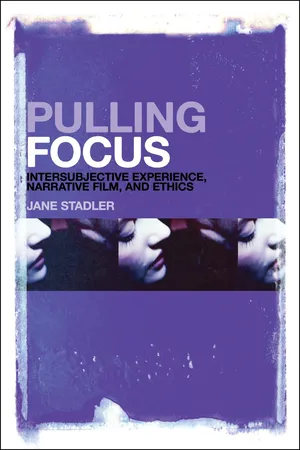
- 288 pages
- English
- PDF
- Available on iOS & Android
About this book
T he most powerful films have an afterlife. Their sensory appeal and their capacity to elicit involvement in story, character and conflict reaches beyond the screen to subtly reframe the way spectators view ethical issues and agents within the narrative, and in the world outside the cinema. Pulling Focus: Intersubjective Experience and Narrative Film questions how cinematic narratives relate to and affect ethical life. Extending Martha Nussbaum and Wayne Booth's work on moral philosophy and literature to consider cinema, Dr. Stadler shows that film spectatorship can be understood as a model for ethical attention that engages the audience in an affective relationship with characters and their values. Building on Vivian Sobchack's Address of the Eye and Carnal Thoughts, she uses a phenomenological approach to analyse ethical dimensions of film extending beyond narrative content, arguing that the camera describes experience and views screen characters with an evaluative form of perception: an ethical gaze in which spectators participate. Films discussed include Dead Man Walking, Lost Highway, Batman Begins, Nil By Mouth, and Eternal Sunshine of the Spotless Mind.
Frequently asked questions
- Essential is ideal for learners and professionals who enjoy exploring a wide range of subjects. Access the Essential Library with 800,000+ trusted titles and best-sellers across business, personal growth, and the humanities. Includes unlimited reading time and Standard Read Aloud voice.
- Complete: Perfect for advanced learners and researchers needing full, unrestricted access. Unlock 1.4M+ books across hundreds of subjects, including academic and specialized titles. The Complete Plan also includes advanced features like Premium Read Aloud and Research Assistant.
Please note we cannot support devices running on iOS 13 and Android 7 or earlier. Learn more about using the app.
Information
Table of contents
- Cover
- HalfTitle
- Title
- Copyright
- Contents
- List of Figures
- Acknowledgments
- Introduction
- 1. Ethics in Narrative Form and Content
- 2. Intersubjective Perception: Phenomenology, Embodiment, and Evaluation
- 3. Losing the Plot: Narrative Structure and Ethical Identity
- 4. Under the Influence: Vice, Violence, and Villainy
- 5. Resistance and Responsiveness: Emotion and Character Engagement
- 6. Imagination: Inner Sight and Silent Voices
- 7. Seeing in the Dark: Attentive Engagement
- Conclusion: Ethical Transformation
- References
- Filmography
- Index